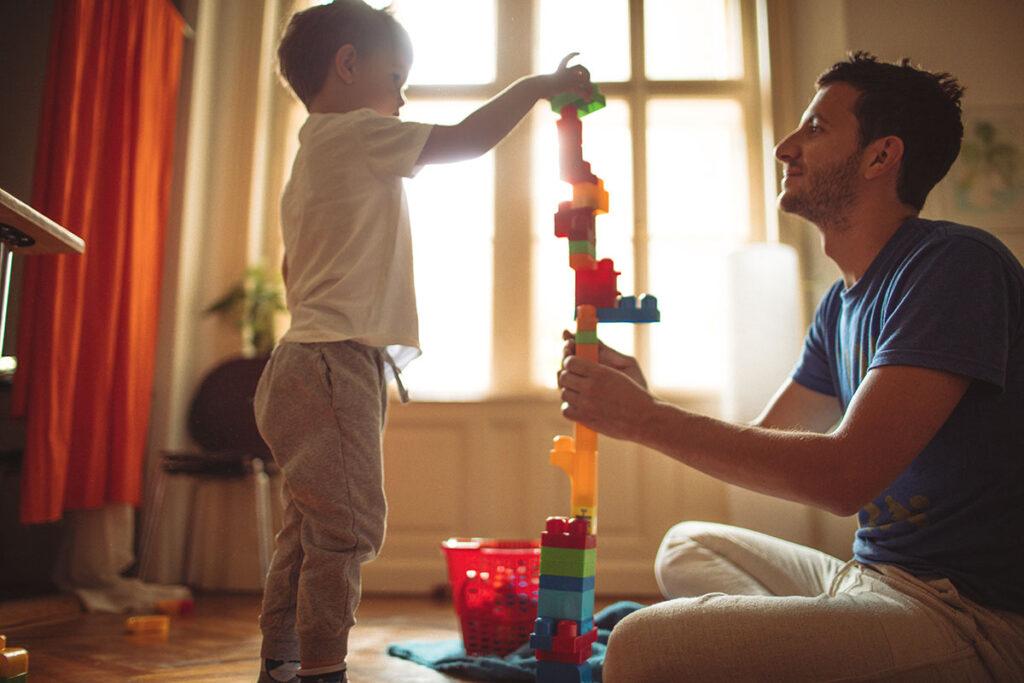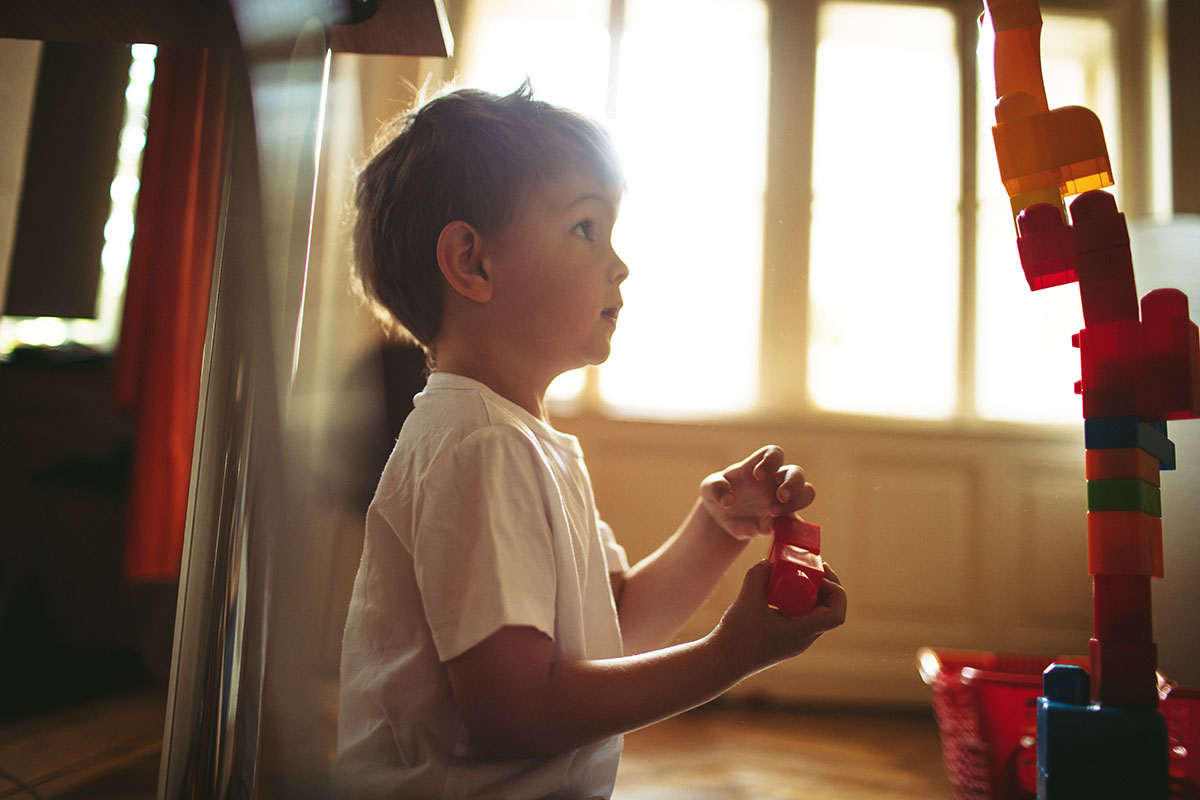Colourful plasticine figures, paper crafts and wooden blocks – children do a lot of handicrafts and building, especially when they are young. And not just because it’s fun. So-called construction play fulfils a particular purpose: it promotes children’s development. This type of play begins in the second year of life. Before that, children have already gathered a lot of information about the building material in object play – by touching and tasting objects. In construction play, said information is used to handle the materials explored creatively. In this blog post, we explain how construction play supports your child’s development and how you can provide additional support.
Table of contents
- This is how construction play develops children’s skills
- The two types of building
- Construction play in pairs – the advantages of building together
- Other forms of construction play
- Construction play: The suitable toy makes the difference
Read more about the early learning process and how play contributes to your child’s development in our blog article: “Play development in early childhood: what are the types of play?
This is how the construction game promotes children’s skills
Cognitive skills
In general, construction play is about using tools to make a product, such as a drawing, a building or a clay figure. In order for this to be successful, children must first think about what the final result should look like. Consequently, they have to create a plan in their heads and follow it during the construction process. This requires both a systematic approach and cognitive ability.
Since construction games require a high level of attention, they can also be regarded as concentration games. They thus simultaneously train children’s ability to concentrate on a certain activity over a certain period of time. Once the work of art has been made or a tower built, the child experiences a clear sense of achievement. This gives the knowledge of having successfully accomplished something and the self-confidence to successfully repeat the process.
Motor skills
In addition, children practise handling their first tools, such as crayons or craft scissors, in construction play. They learn how they work and how to manage them effectively. This not only promotes the concentration skills already mentioned but also fine motor skills. It also imparts new knowledge about the properties of objects and helps children test legal limits. For example, painting with watercolours reveals that a lot of water makes the paint run across the paper. Or playing with building blocks shows that no two wooden balls can be stacked on top of each other, but two wooden cubes can.
The two types of construction
In construction play, a distinction is made between two different types of building: experimental building and constructive building. The first type of building forms a basis for the second type.
Experimental building
In the beginning, the children have little or no previous experience and gain it by trying out different materials or objects. The experimental building is very free play or building without a predefined goal. In this case, building also includes the subsequent destruction of the structure. Experimental building thus includes connecting different objects and materials as well as taking them apart.
Constructive building
This is a more demanding variant of the building game. The basis, in this case, is play materials that are offered in a structured form. It is not about simply building anything, but about building according to rules and proceeding with sense and understanding, i.e. planned.

Construction game for two – the advantages of building together
Building alone is fun, but building in pairs or threes is even more so. And the best thing about it: Regularly building and tinkering together has advantages that children benefit from in the long term.
- Building together strengthens social competence: Building with a partner means not only being able to assert one’s own interests. Every child who is involved in the handicraft or building project has a say. In order to play together harmoniously, children must always show consideration for each other and listen to each other. This promotes the child’s social interaction with others and makes it a better team player in the long term.
- Building together trains communication skills: A construction with two master builders can only succeed with constant consultation. Consequently, each child has to explain his or her own building project to his or her building buddy and describe how he or she envisages the construction in the end. In this way, they practise reflecting on their own actions as well as verbal expression and, of course, conversation.
- Building together means learning from each other: If two children work together, at best, they also decide together on the building project. This gives each child the opportunity to learn from each other’s ideas or to get to know new building techniques and to try them out, adapt them and practise them themselves.
Other forms of construction play
It doesn’t necessarily have to be building blocks. Older children, in particular, usually no longer see any attraction in them. However, the construction game comes in a wide variety of forms and can be easily adapted to the respective age group and the preferences of your child. But beware: it’s the variety that counts! And trying out something new never hurt anyone.c
- Inventive with construction toys (Lego, Duplo, etc.): The upgrade to the initial building blocks is a great way to be inventive and let off steam with building blocks and construction elements. Game idea: Build the same object independently of each other – a privacy screen helps here against secret peeking. The different results are amazing, inspire and often bring new ideas!
- Creative with sand: Whether on the playground or in the garden – a sandpit always goes down well with children. And with sand, you can create much more than the classic sandcastle. A bucket full of water and the dug ravines become a river system. Have you ever tried to build furniture out of sand? Or shoes that you can even climb into?
- Modelling with modelling clay: jewellery, play figures or something completely different? There are no limits to your imagination with modelling clay. By the way, light-coloured salt dough is easy to make yourself, and you can even paint it colourfully after it has dried. This is a great way to make homemade toys such as animal figures or fruit and vegetables for the shop.
- Make new things from everyday objects: Craft materials don’t have to be expensive, but above all, they don’t always have to be bought new. Everyday objects such as empty toilet paper or kitchen towel rolls, cardboard boxes and PET bottles are often a great alternative and can be given a second life. Popsicle sticks also make excellent building material for fences and railway tracks and offer a great reason to eat ice cream again!
Construction play: The right toy makes the difference
You can motivate your child to play construction games at any time by taking the time to tinker or build something with them. However, the promotional character of construction play can also be easily integrated into everyday play. Appropriate toys are the key here! It is best to provide your child with toys that do not limit their imagination and creativity. Large, prefabricated plastic parts that cannot be changed are instead a hindrance here. It is better to use elements that can be used in a variety of ways or at least combined in different ways, as they can always be used to build something new. Instead of buying a ready-made zoo, for example, let your children put together their own enclosures for their animal figures and equip them individually. This way, the children are challenged to construct the part they need for their game themselves – and the game itself becomes more accessible and more exciting.
The construction game works great as such – but can also be combined with other types of play. With role-playing, for example! This is another excellent way to advance your child’s development while having fun. You can read more about this in our blog post: “Role play is so important: Encouraging children through play!”
Image 1 : Aleksandar Nakic / Signature Collection / istockphoto.com
Image 2 : Aleksandar Nakic / Signature Collection / istockphoto.com

